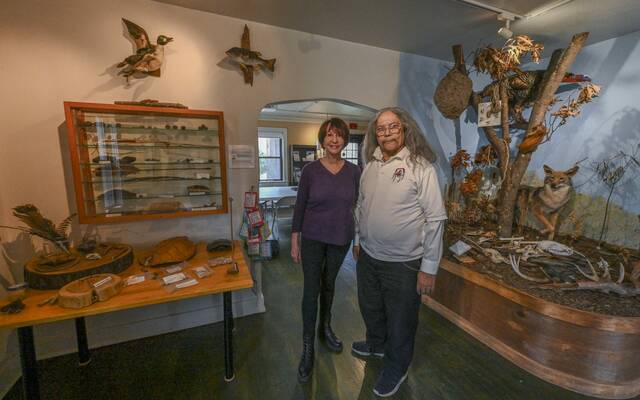New Harrison Hills exhibit showcases 'Native Americans of the Allegheny Valley'
A small-scale replica of a Native American longhouse sits among artist Robert Griffing’s depictions of 17th-century life in a new display at the Harrison Hills Environmental Learning Center.
“If you have ever wondered what life was like in our locale before it was densely populated by European settlers, the new exhibit will be of interest,” said Susan Goughler, a member of the Friends of Harrison Hills advisory board.
“We wanted to show who lived right here in Tarentum, Natrona Heights and Freeport, so we put together a display on who they were, how they played, how they sustained themselves and who they feared.”
The group is eyeing a June open house to launch the exhibit, “Native Americans of the Allegheny Valley.”
Harrison Hills encompasses more than 500 acres of woods, ponds and streams off Freeport Road in Harrison. It’s owned by Allegheny County.
The display, though small in stature, details the huge significance the local region played in Native American settlements.
“Tarentum was of major importance to the daily life of both the Indian tribes and the settlers,” Goughler said. “Paramount to the way of life was the trading post on Bull Creek opened by Pierre Chartiers, who lived in the area we now know as Tarentum.”
Goughler collaborated with Miguel Sague Jr., an artist from Penn Hills and board member of the Council of Three Rivers American Indian Center in Dorseyville, to curate the project.
“Because the property was dominated by Seneca indigenous people,” Sague said. “I thought it would be nice to have a 3D display of a traditional longhouse.”
“I think people will be surprised at how it looks much more like it’s from the modern era than, maybe, their stereotypical idea of a teepee,” Sague said. “The roof has a smoke hole, like a chimney, and people will be able to see inside.”
Goughler said the new exhibit is the perfect complement to the center’s existing educational displays, which include bird and bloom photos by Friends’ board member Dave Brooke.
There is a “touch and feel” table with a beaver paw, turkey foot, snake skins, antlers, cowhide, seed pods and other nature items.
Other exhibits feature Madagascar hissing roaches, giant millipedes and butterflies.
“We have this learning center that has a wonderful room of stuffed species, and we wondered what we could do to make the front room educational and inviting,” Goughler said.
“I truly never wondered who walked the towns of the city where I lived until I moved here. Everyone liked the idea, and we thought it would probably be of local interest.”
Sague’s expertise catapulted the project toward excellence, Goughler said.
“I was hoping to get 20 minutes on the phone with him. We talked for hours, and then I had plenty of information to research,” she said.
“He is passionate about educating and sharing his vast knowledge with others.”
The pair said they hope guests take away an understanding of Native American cultures and ways of life.
Visitors to the center will get lessons on the “three sisters” way of gardening that clusters corn, beans and squash, and also on early recreation such as lacrosse.
“For them, lacrosse wasn’t just a game. It was the way they settled some disputes, and it took on a spiritual component,” Goughler said.
“Primarily, I know there are some people that think all Native Americans are the same, and that’s not the case. I want them to take away how clever they were and how some of the things they implemented we still use today.”
Tawnya Panizzi is a TribLive reporter. She joined the Trib in 1997. She can be reached at tpanizzi@triblive.com.
Remove the ads from your TribLIVE reading experience but still support the journalists who create the content with TribLIVE Ad-Free.



